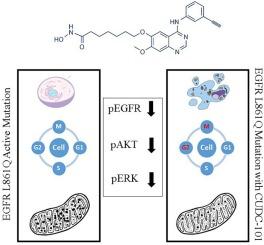CUDC-101 对具有罕见表皮生长因子受体 L861Q 突变的非小细胞肺癌细胞的细胞毒性和抑制潜力
IF 2.9
Q2 TOXICOLOGY
引用次数: 0
摘要
表皮生长因子受体(EGFR)是治疗非小细胞肺癌的有效靶点。在治疗传统的表皮生长因子受体突变时,表皮生长因子受体酪氨酸激酶抑制剂取得了理想的临床疗效。然而,酪氨酸激酶抑制剂(TKIs)对L861Q突变的疗效尚未完全确定。本研究通过CRISPR技术构建了四种含有L861Q突变的细胞系,并以阿法替尼为阳性对照,采用多种化疗敏感性方法在体外研究了CUDC-101对它们的抗肿瘤作用。结果表明,CUDC-101通过ERK或AKT途径抑制了四种细胞的增殖和克隆能力,降低了细胞的线粒体膜电位,阻滞了细胞周期,促进了细胞凋亡。我们的研究结果表明,CUDC-101可能是治疗表皮生长因子受体18外显子置换突变L861Q的NSCLC患者的一种很有前景的选择。本文章由计算机程序翻译,如有差异,请以英文原文为准。

Cytotoxicity and inhibitory potential of CUDC-101 in non-small cell lung cancer cells with rare EGFR L861Q mutation
The epidermal growth factor receptor (EGFR) represents an effective target for the treatment of non-small cell lung cancer. In the treatment of classical EGFR mutations, EGFR tyrosine kinase inhibitors have achieved desirable clinical efficacy. However, the effectiveness of tyrosine kinase inhibitors (TKIs) against the L861Q mutation has not been fully established. In this study, the four cell lines containing the L861Q mutation were constructed by CRISPR and the anti-tumour effects of CUDC-101 on them were investigated in vitro by various chemosensitivity methods, with afatinib serving as a positive control. The results demonstrated that CUDC-101 inhibited the proliferation and clonogenic capacity on the four cells through the ERK or AKT pathways, decreased the mitochondrial membrane potential of the cells, blocked the cell cycle and promoted apoptosis. Our findings suggest that CUDC-101 may be a promising treatment option for NSCLC patients with the EGFR exon 18 substitution mutation L861Q.
求助全文
通过发布文献求助,成功后即可免费获取论文全文。
去求助
来源期刊

Current Research in Toxicology
Environmental Science-Health, Toxicology and Mutagenesis
CiteScore
4.70
自引率
3.00%
发文量
33
审稿时长
82 days
 求助内容:
求助内容: 应助结果提醒方式:
应助结果提醒方式:


